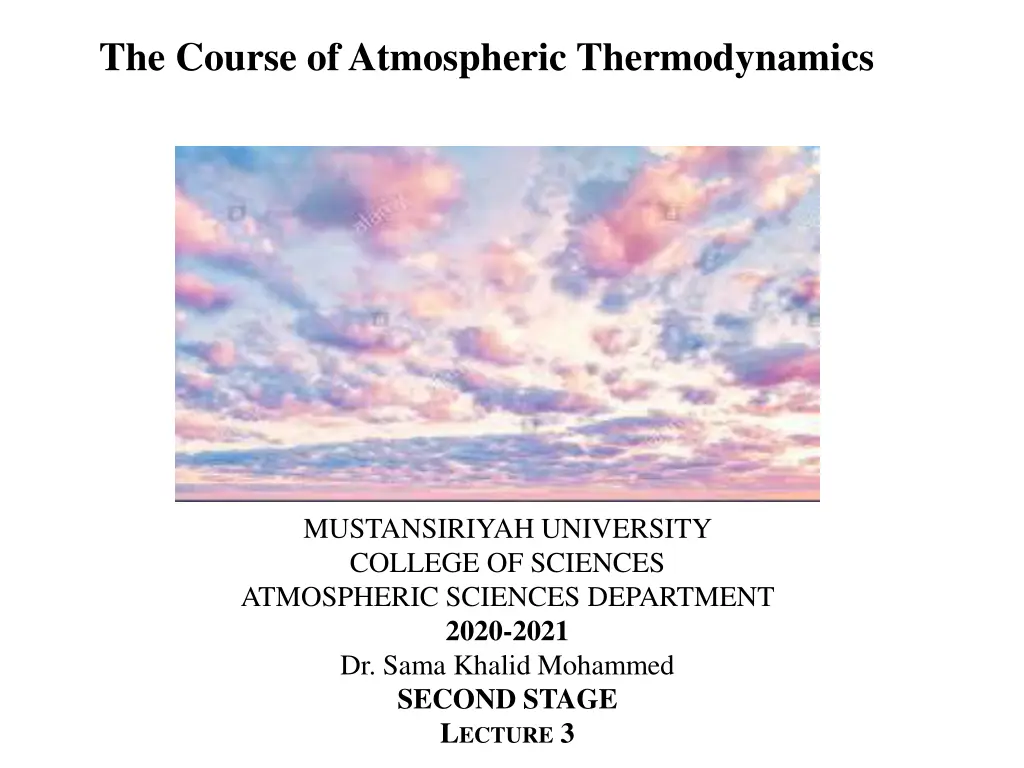
Understanding Atmospheric Thermodynamics: Humidity, Stability, and Moisture Measurements
Explore the concepts of humidity, stability, and various humidity measurements in atmospheric thermodynamics. Learn about relative humidity, mixing ratios, dew point, and more. Understand how different factors influence the moisture content in the air.
Download Presentation

Please find below an Image/Link to download the presentation.
The content on the website is provided AS IS for your information and personal use only. It may not be sold, licensed, or shared on other websites without obtaining consent from the author. If you encounter any issues during the download, it is possible that the publisher has removed the file from their server.
You are allowed to download the files provided on this website for personal or commercial use, subject to the condition that they are used lawfully. All files are the property of their respective owners.
The content on the website is provided AS IS for your information and personal use only. It may not be sold, licensed, or shared on other websites without obtaining consent from the author.
E N D
Presentation Transcript
The Course of Atmospheric Thermodynamics MUSTANSIRIYAH UNIVERSITY COLLEGE OF SCIENCES ATMOSPHERIC SCIENCES DEPARTMENT 2020-2021 Dr. Sama Khalid Mohammed SECOND STAGE LECTURE 3
THIS LECTURE INCLUDING THE FOLLOWING ITEMS SOME NOTES ABOUT HUMIDITY STABILITY A STABLE ATMOSPHERE. AN UNSTABLE ATMOSPHERE. STABILITY IN A DRY ATMOSPHERE STABILITY IN MOIST ATMOSPHERE POTENTIAL TEMPERATURE
STOP & THINK ! MOIST AIR PARTIAL PRESSURE VAPOR PRESSURE SATURATION VAPOR PRESSURE SPECIFIC HUMIDITY MIXING RATIO & Saturation MIXING RATIO DEW POINT TEMPERATURE RELATIVE HUMIDITY WET BULB TEMPERATURE
STOP & THINK ! Specific humidity, mixing ratio, vapor pressure, and dew point remain unchanged if the air parcel is heated or cooled at constant pressure. In other words, if I want to compare two air samples to find which has more water vapor, I can directly compare their mixing ratios, vapor pressures, specific humidity, or dew points. The one with the higher number will have more water vapor. I can compare the samples without worrying about whether they are at the same temperature or not (however, vapor pressure will have to be compared at the same air pressure)! This is not true of absolute humidity, which will change as the air parcel is heated or cooled.
STOP & THINK ! Relative Humidity is a measure of the actual amount of water vapor in the air compared to the total amount of vapor that can exist in the air at its current temperature. It tells us how close an air parcel is to saturation( It does not directly tell us how much water vapor is in the parcel!) A parcel with higher relative humidity may actually have less water vapor than another parcel with lower relative humidity! Warm air can possess more water vapor (moisture) than cold air, so with the same amount of absolute/specific humidity, air will have a HIGHER relative humidity if the air is cooler, and a LOWER relative humidity if the air is warmer. What we "feel" outside is the actual amount of moisture (absolute humidity) in the air.
How to Change Some Humidity Measurements There are two ways to change the relative humidity, or absolute humidity of an air parcel: Add or subtract water vapor. Change the temperature. There is only one way to change mixing ratio, specific humidity, vapor pressure, or dew point (assuming pressure is constant): Add or subtract water vapor.
Converting RH to DD Recall from the previous lecture, ?? 100%=? ? ?? ?? So, A simple rule of thumb for converting RH to a dew point depression DD = (T - Td) for moist air (RH >50%) is that Td decreases by 1 C for every 5% decrease in RH (starting at Td = T(dry bulb temperature , where RH = 100%). For example, if the RH is 85%, and the dew point depression is T - Td = 3 C.
THE DEW-POINT TEMPERATURE AND RELATIVE HUMIDITY At the Earth s surface, the pressure typically varies by only a few percent from place to place and from time to time. Therefore, the dew point is a good indicator of the moisture content of the air. In warm, humid weather the dew point is also a convenient indicator of the level of human discomfort. For example, most people begin to feel uncomfortable when the dew point rises above 20 C, and air with a dew point above about 22 C is generally regarded as extremely humid or Fortunately, dew points much above this temperature are rarely observed even in the tropics. sticky.
THE DEW-POINT TEMPERATURE AND RELATIVE HUMIDITY In contrast to the dew point, relative humidity depends as much upon the temperature of the air as upon its moisture content. On a sunny day the relative humidity may drop by as much as 50% from morning to afternoon, just because of a rise in air temperature. Neither is relative humidity a good indicator of the level of human discomfort. For example, a relative humidity of 70% may feel quite comfortable at a temperature of 20 C, but it would cause considerable discomfort to most people at a temperature of 30 C.
THE DEW-POINT TEMPERATURE AND RELATIVE HUMIDITY The highest dew points occur over warm bodies of water or vegetated surfaces from which water is evaporating. In the absence of vertical mixing, the air just above these surfaces would become saturated with water vapor, at which point the dew point would be the same as the temperature of the underlying surface. Complete saturation is rarely achieved over hot surfaces, but dew points in excess of 25 C are sometimes observed over the warmest regions of the oceans.
Just To Remind You The numerical value of the saturated adiabatic lapse rate s varies with pressure and temperature, s < d. Actual values of s range from about 4 K/km near the ground in warm, humid air masses to typical values of 6-7 K/km in the middle troposphere.
STABILITY Stability refers to whether an air parcel, one moved vertically, will continue to accelerate in the direction that it was pushed (unstable), or return in the direction from which it came (stable).
A stable atmosphere. An absolutely stable atmosphere exists when a rising air parcel is colder and heavier (i.e., more dense) than the air surrounding it. If given the chance (i.e., released), the air parcel in both situations would return to its original position, the surface. An unstable atmosphere. An absolutely unstable atmosphere exists when a rising air parcel is warmer and lighter (i.e., less dense) than the air surrounding it. If given the chance (i.e., released), the lifted parcel would continue to move away (accelerate) from its original position
STABILITY IN A DRY ATMOSPHERE Variables with a prime are properties of the air parcel. Variables without a prime refer to the surrounding, environmental air.
Stability of Saturated Air The parcels will be: stable when < s, Neutral = s , Unstable > s
POTENTIAL TEMPERATURE The potential temperature of an air parcel is the temperature that the parcel of air would have if it were expanded or compressed adiabatically from any state (T, p) to a standard pressure of p0 = 1000 hPa. From the Poisson relation for T and p [Eqn. (4) in lec 7 course 1] we get =T p levels ( p=800,700,1016) and for temperature (T= 288 Kelvin), and you will find the same value for each level Use the equation above and find out the potential temperature for different pressure p0 Rdcp Rdcp = 0.2 = potential temperature T = original temperature P = original pressure P0= standard pressure = 1000 hPa If an air parcel undergoes an adiabatic process its potential temperature is conserved.






















